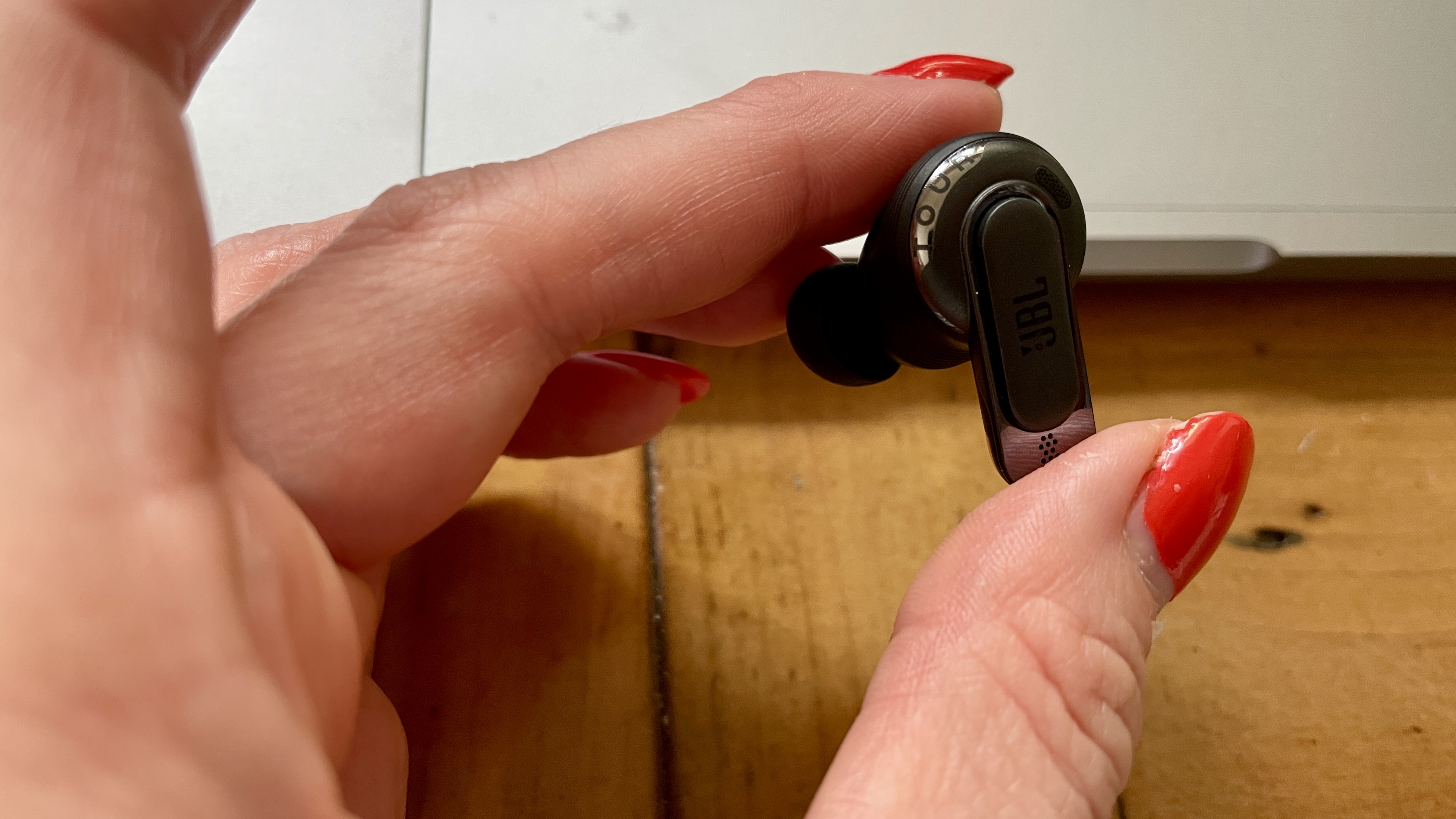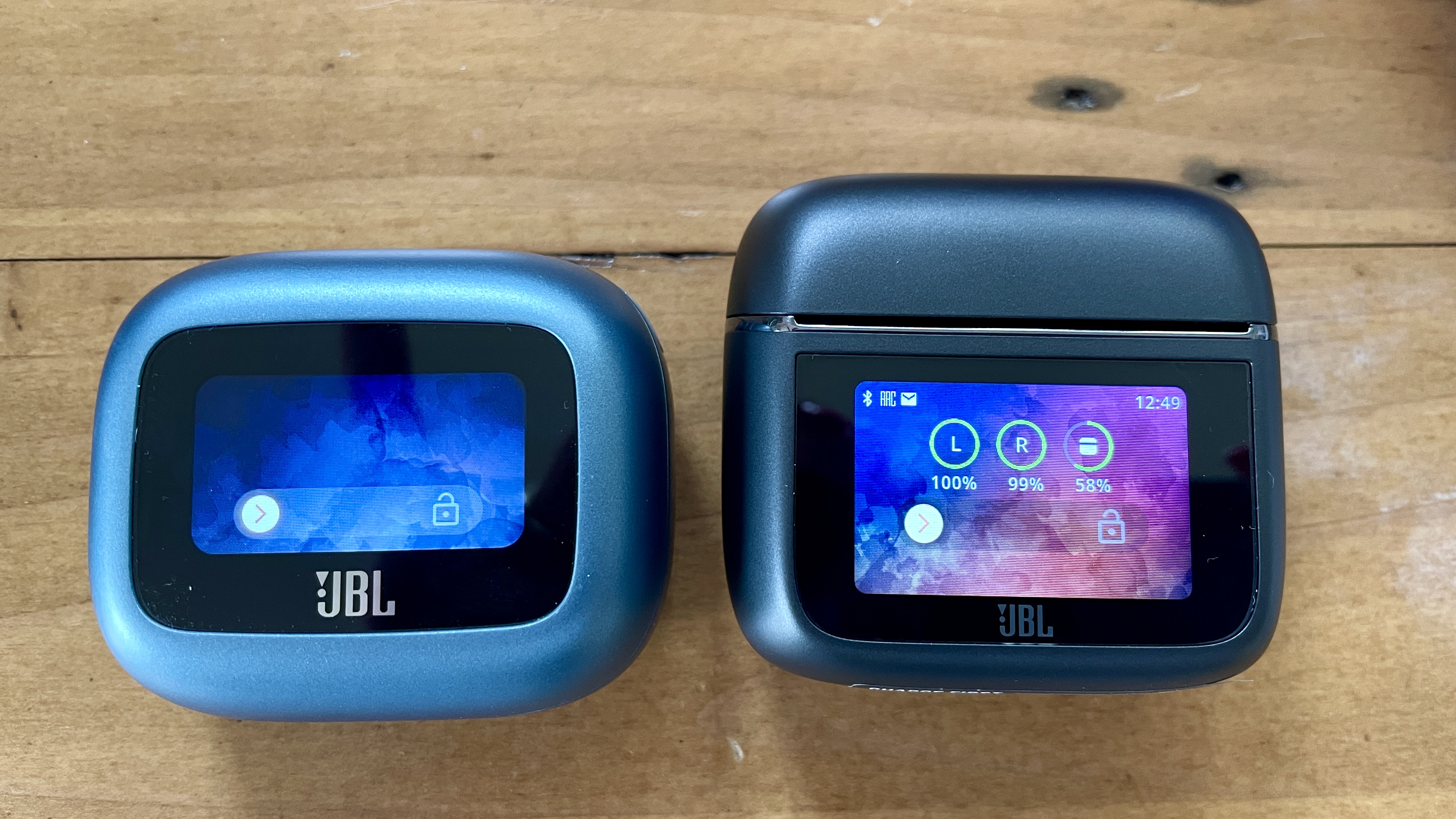JBL unveils Tour Pro 3: a screen-toting earbuds case that's now an Auracast source device
Password protected – you don't want everyone joining the 'cast

In this day and age, you don't have to pay flagship money to get a futuristic lock-screen-image-toting earbuds case; JBL made that available not only with its JBL Live Beam 3, but across its mid-range earbuds oeuvre in January 2024 comprising the JBL Live 3 Buds, Beam and Flex.
I liked it so much, I wrote a feature dedicated to the levelled up experience in JBL's second-gen smart-case earbuds – because in case you missed it in December 2022, when JBL first put a smartwatch-style screen on an earbuds case, our subsequent JBL Tour 2 Pro review revealed that we weren't wholly convinced that this first effort was anything other than a colorful novelty.
But because that second smart case was so good that it made it to our best noise-cancelling earbuds guide as our 'best for battery' pick, I'm eager to see what JBL can do with its third effort, this time in a flagship proposition. And putting the case to one side, what about the spec-sheet and audio chops?
Well, this is not a full review. But I do happen to have a review sample of JBL's just-launched (August 21) Tour Pro 3 right here, and I can give you some early facts, figures, thoughts, and impressions (spoiler alert: it's good news).
JBL Tour Pro 3: what you need to know

Scroll for a selection of new features

Scroll for a selection of new features



First off, you get two color choices – black and 'latte' – and although JBL is a little vague about the exact dimensions, the company does tell me that the screen is 30% larger and the case a little smaller in this iteration. Certainly, the screen is bigger than that of the Live Beam 3, and the case a little smaller than that of the Tour Pro 2 (scroll down to the image below for a side-by-side comparison).
I'll start with what I see as the biggest updates here. First off, this case is now a transmitter (see the Jabra Elite 10 Gen 2 or LG Tone Free T90S for similar) meaning that with the included USB-A to USB-C cable, it's able to bypass Bluetooth, hook up to your in-flight infotainment systems (for example) and broadcast the audio to your wireless earbuds. But more than that, the JBL Tour Pro 3's case is one of the first audio products to arrive as a registered Auracast source device. Essentially, that means anyone in the vicinity with Auracast-enabled headphones could also join in, to hear the sound being transmitted, and you can add a password if you don't want random passers-by joining your broadcast.
Next up, JBL's Spatial Audio 360 is here (scroll to the image of 'spatial audio' options on the smart case, above) which includes head-tracked, device-agnostic immersive audio aided by an updated algorithm. I haven't had a lot of time with it, but initially, it's remarkable. While listening to Melissa Etheridge's I'm the Only One, I forgot I was wearing earbuds as her textured vocal appeared to emanate from somewhere close to my phone, even as I turned my head.
Sign up for breaking news, reviews, opinion, top tech deals, and more.
JBL has added L/R balance optimization, 12 EQ bands to tailor things sonically and – a big one for me – JBL's new Personi-Fi 3.0 update. For the uninitiated (it's okay, we're all friends here), this feature helps to personalize the sound to your liking, creating a sound profile based on your hearing capabilities. It first asks a few questions, then checks your current ambient audio – and I absolutely loved Personi-Fi 2.0, in the Live Beam 3.
What about the noise cancellation?

Good question: but to explain what's new there, we need to talk hardware first. Under the driver housing (which is on the larger side, but nicely ergonomic and you do get five ear tips to ensure a good fit) there's now a hybrid 10.2mm cellulose dynamic driver coupled with a 5.1mm x 2.8mm balanced armature setup. Here, JBL tells me frequencies from 20Hz (aka the lowest our ears can detect) up to 8kHz are handled by the dynamic drive unit; 8kHZ-40kHz (or far beyond what we can hear) sounds are taken care of by the BA driver configuration – and interestingly, each has its own DAC to convert the digital signal to analogue.
Codecs support is better too: in addition to SBC and AAC, hi-res LDAC joins the party as well as LE Audio and the LC3 codec in dongle mode (i.e., transmission mode).
Thanks to a total of six mics (two outer; one inner) and an enhanced algorithm that uses AI, there's a call equalizer function to regulate the volume of the caller on the other end, and you can even make your own voice appear brighter to your caller.
Now, the noise cancellation – because again, it's a big deal on paper. JBL claims its aforementioned AI algorithm plus the company's True Adaptive Noise Cancellation 2.0 with 'smart calibration' should actually be able to tackle what it calls 'incident noises' (think a baby crying on the train) in addition to the low-level constant thrums which most solutions can tackle quite readily these days. I haven't had a thorough test of it yet, but can tell you that after receiving them, I sat in a blissful bubble of silence in the office.
Battery life? The claim is up to 44 hours of music playback – 11 hours from the buds plus three more full charges with ANC off – or eight hours plus three more full charges with ANC on for a 32-hour total if you're always using ANC. And you can apparently get an additional three hours of listening with a quick 10-minute speed charge.
Pricing? Of course, although you'll need to brace yourself: £279.99 / €299.99 (which is around $365 or AU$540). For clarity, the older Tour Pro 2 launched in January 2023 at MSRPs of $249.95 / £220 / AU$350, so there's been something of a price hike, although given the specs listed, it's not unreasonable.
This is, again, not a full review. But that's in the pipeline, I promise you…

You may also like
- See our pick of the best waterproof headphones
- Want a portable music streaming device that's not your phone? Check out our roundup of the best hi-res audio players on the market
- Know your FLAC from your ALAC and get into hi-res audio with our audio file format explainer

Becky became Audio Editor at TechRadar in 2024, but joined the team in 2022 as Senior Staff Writer, focusing on all things hi-fi. Before this, she spent three years at What Hi-Fi? testing and reviewing everything from wallet-friendly wireless earbuds to huge high-end sound systems. Prior to gaining her MA in Journalism in 2018, Becky freelanced as an arts critic alongside a 22-year career as a professional dancer and aerialist – any love of dance starts with a love of music. Becky has previously contributed to Stuff, FourFourTwo and The Stage. When not writing, she can still be found throwing shapes in a dance studio, these days with varying degrees of success.